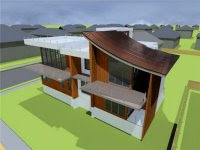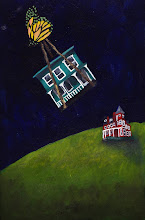


 The Audubon House
The Audubon House is a bit of a misnomer. Having visited the property for an extended stay when he was illustrating his catalogue of North American birds, Audubon never actually lived in the house. It's a small detail, with the beautifully restored home and lush grounds housing a fantastic Audubon print collection. Built after the area was decimated in the mid-19
th century by a hurricane, this captain's house stocked with antiques and artwork holds original double elephant and
octavio prints, becoming a lesson in art, biology, and the printing industry. Dedicated to catalogue the appearance and habitat of birds, Audubon released a variety of field guide print editions, thus making the masterful images affordable for the masses. After chatting with the very helpful and knowledgeable gallery manager Martha
Resk, James and I couldn't help but invest in one-- a third edition
octavio from 1859. This
handpainted printed lithograph of dwarf thrush inspired me to revamp a collage that I never really liked. Maybe all it needed was a bird.



 The Audubon House is a bit of a misnomer. Having visited the property for an extended stay when he was illustrating his catalogue of North American birds, Audubon never actually lived in the house. It's a small detail, with the beautifully restored home and lush grounds housing a fantastic Audubon print collection. Built after the area was decimated in the mid-19th century by a hurricane, this captain's house stocked with antiques and artwork holds original double elephant and octavio prints, becoming a lesson in art, biology, and the printing industry. Dedicated to catalogue the appearance and habitat of birds, Audubon released a variety of field guide print editions, thus making the masterful images affordable for the masses. After chatting with the very helpful and knowledgeable gallery manager Martha Resk, James and I couldn't help but invest in one-- a third edition octavio from 1859. This handpainted printed lithograph of dwarf thrush inspired me to revamp a collage that I never really liked. Maybe all it needed was a bird.
The Audubon House is a bit of a misnomer. Having visited the property for an extended stay when he was illustrating his catalogue of North American birds, Audubon never actually lived in the house. It's a small detail, with the beautifully restored home and lush grounds housing a fantastic Audubon print collection. Built after the area was decimated in the mid-19th century by a hurricane, this captain's house stocked with antiques and artwork holds original double elephant and octavio prints, becoming a lesson in art, biology, and the printing industry. Dedicated to catalogue the appearance and habitat of birds, Audubon released a variety of field guide print editions, thus making the masterful images affordable for the masses. After chatting with the very helpful and knowledgeable gallery manager Martha Resk, James and I couldn't help but invest in one-- a third edition octavio from 1859. This handpainted printed lithograph of dwarf thrush inspired me to revamp a collage that I never really liked. Maybe all it needed was a bird.





1 comment:
What an interesting post. That house is fantastically pretty!
Post a Comment